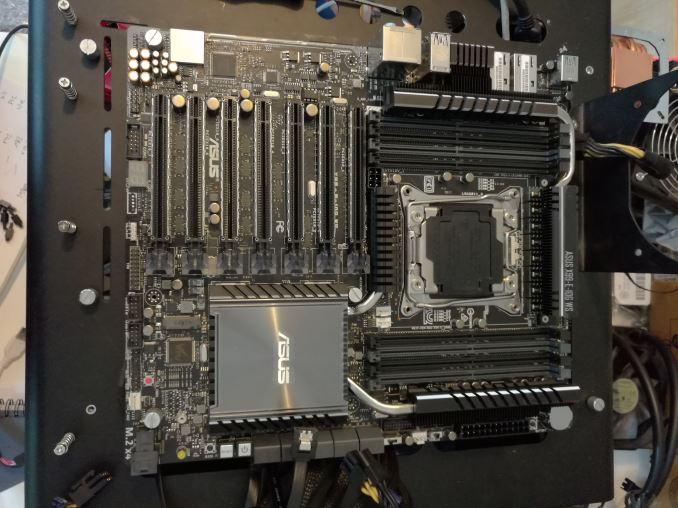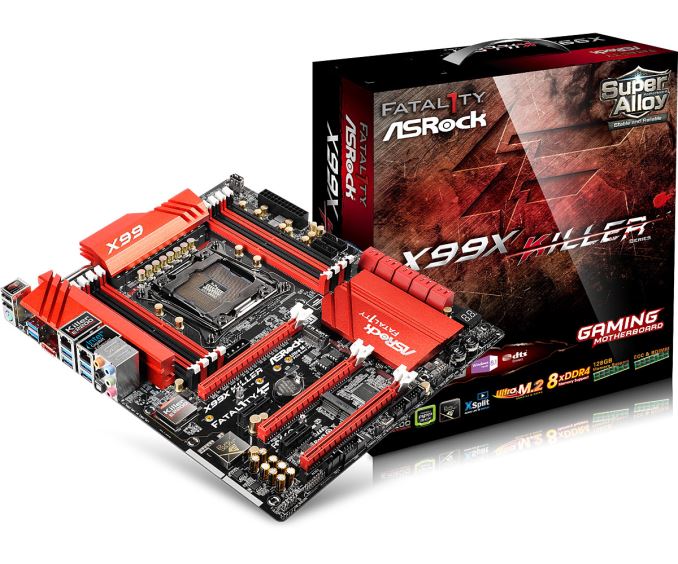The Intel Broadwell-E Review: Core i7-6950X, i7-6900K, i7-6850K and i7-6800K Tested
by Ian Cutress on May 31, 2016 2:01 AM EST- Posted in
- CPUs
- Intel
- Enterprise
- Prosumer
- X99
- 14nm
- Broadwell-E
- HEDT
The Market
At this point in time, Intel is primarily competing with itself. Because the enterprise market requires consistency, the HEDT platform is constrained to that three year, two product cycle, which maintains enough consistency in socket compatibility to keep the enterprise partners happy. When Intel has 95%+ of the HEDT and x86 enterprise market, rather than increasing market share to generate revenue, Intel has to convince users on older systems that their new products are worth the investment. That’s an easy sell in the enterprise market, as time is money and total cost of ownership for a system is typically well documented for cyclical updates.
For HEDT, making that case to prosumers can be difficult. It depends on budgets and how applications are developing, especially when a number of popular professional software packages are (where possible) trying to leverage PCIe accelerators. There will always be a strong market for CPU performance, and there will always be a market for HEDT, depending on the price. But at some point the HEDT and Xeon markets do collide, and the two main factors on this are price and availability.
As mentioned earlier, the newly introduced Broadwell-E Core i7 parts collide in price with a number of Broadwell-EP Xeon parts, which could suggest that Intel wants to push potential prosumers (especially the professional ones) more into systems made by enterprise and workstation partners. These systems are typically sold with appropriate support, and the two platforms differ by a few features. The question becomes about who is buying HEDT: a number of users reading this will be gamers, and will not be interested in workstation sellers.
It’s a strange balance that Intel is trying to strike. Everyone wants more – whether they need it or not is a different conversation – but most enthusiasts say they want more. Intel states that as a company, it supports the gamers and the enthusiasts who want to push their consumer platforms to the fullest, and something like Broadwell-E does that. However a prohibitive price might reduce the potential number of next generation enthusiasts who want to play at the high-end.
X99 Refresh Motherboards
Throughout this month many of the regular motherboard manufacturers have either released, announced, or teased newer "refresh" motherboards using the LGA2011-3 socket and the X99 chipset. We’ve got a base roundup of all the new motherboards coming out of Computex planned, especially as new models are being announced and shown at the show. A couple of these landed on our desk for Broadwell-E testing, such as the MSI X99A Gaming Pro Carbon:
The Carbon is a relatively new brand for MSI’s motherboard range, typically on the high-end models, and this one aims for a deep black aesthetic that is enhanced through the additional LED lighting.
We also have in the ASUS X99-E-10G WS motherboard, ASUS’ high-end workstation and prosumer based motherboard that also integrates an Intel X550-T2 10 gigabit Ethernet chip offering two 10GBase-T ports. We’ve seen this before on the ASRock X99 WS-E/10G, which used the X540-T2, and required eight PCIe 3.0 lanes from the CPU to provide enough bandwidth. We were only able to test the ASUS 10G board for a couple of days before leaving for Computex, and will have a preview up shortly.
ASRock also sent us their X99X Killer, although the courier tried to deliver on a day where I spent 30 minutes gathering stuff for the Computex trip. Go figure. It’ll be ready to test when I get back!
This Review
As with every CPU launch, there are a number of different directions to take our review. In our review of the launch of the consumer Broadwell parts, the i7-5775C and the i5-5675C we examined the generational update over previous architectures, and thus won’t repeat those tests here. We have had almost every high-end desktop CPU since Sandy Bridge-E in-house at some point, although only the latest have been through our most recent benchmark suite. Due to timing, we were able to test all four of the new Broadwell-E processors, and retest the three Haswell-E processors, however we have a more limited dataset for comparison to Ivy Bridge-E, Sandy Bridge-E and Nehalem/Westmere. It will be interesting to see how the CPU performance for the HEDT has adjusted over the last five generations.
The other angle is the recent release of Intel’s Skylake mainstream focused processors, such as the i7-6700K and the i5-6600K, which feature a higher single core frequency but fewer cores and fewer memory channels, or the mainstream enthusiast focused Devil’s Canyon processors released back in July 2014. These have been tested on our latest range of benchmarks, and should make it clear where the latest mainstream-to-HEDT crossover should be.
Test Setup
| Test Setup | |
| Processor | Intel Core i7-6950X (10C/20T, 3.0-3.5 GHz) Intel Core i7-6900K (8C/16T, 3.2-3.7 GHz) Intel Core i7-6850K (6C/12T, 3.6-3.8 GHz) Intel Core i7-6800K (6C/12T, 3.4-3.6 GHz, 28 PCIe 3.0) |
| Motherboards | MSI X99A Gaming Pro Carbon |
| Cooling | Cooler Master Nepton 140XL |
| Power Supply | OCZ 1250W Gold ZX Series Corsair AX1200i Platinum PSU |
| Memory | G.Skill RipjawsX DDR4-2400 C15 4x16GB 1.2V |
| Memory Settings | JEDEC @ 2400 |
| Video Cards | ASUS GTX 980 Strix 4GB MSI R9 290X Gaming 4G MSI GTX 770 Lightning 2GB MSI R9 285 Gaming 2G ASUS R7 240 2GB |
| Hard Drive | Crucial MX200 1TB |
| Optical Drive | LG GH22NS50 |
| Case | Open Test Bed |
| Operating System | Windows 7 64-bit SP1 |
Many thanks to...
We must thank the following companies for kindly providing hardware for our test bed:
Thank you to AMD for providing us with the R9 290X 4GB GPUs.
Thank you to ASUS for providing us with GTX 980 Strix GPUs and the R7 240 DDR3 GPU.
Thank you to ASRock and ASUS for providing us with some IO testing kit.
Thank you to Cooler Master for providing us with Nepton 140XL CLCs.
Thank you to Corsair for providing us with an AX1200i PSU.
Thank you to Crucial for providing us with MX200 SSDs.
Thank you to G.Skill and Corsair for providing us with memory.
Thank you to MSI for providing us with the GTX 770 Lightning GPUs.
Thank you to OCZ for providing us with PSUs.
Thank you to Rosewill for providing us with PSUs and RK-9100 keyboards.













205 Comments
View All Comments
JimmiG - Tuesday, May 31, 2016 - link
What's worse than the price premium is that you're also paying for the previous generation architecture.I really don't see why anyone would want one of those CPUs. For gaming and most typical applications, the mainstream models are actually faster because of their more modern architecture and higher clock speeds. If you're a professional user, you should really be looking at Xeons rather than these server rejects.
K_Space - Tuesday, May 31, 2016 - link
Exactly. I think that's the whole point: Intel realizes that -realistically- little profit will be made from these B-Es given the little incremental increase in performance so why not use them as an advert for the Xeons (which they have aggressively been marketing for HEDT not just servers over the last few month). Anyone considering these will consider the Xeons now.Ratman6161 - Tuesday, May 31, 2016 - link
There are a few benchmarks where they do make sense, if and only if you are doing that particular task for your job i.e. an environment where time is money. For the rest of us, if I need to do a video conversion of some kind its relatively rare and I can always start it before I go to bed.retrospooty - Tuesday, May 31, 2016 - link
People belittle AMD because even though Intel has dramatically slowed down the pursuit of speed, AMD still cant catch up. It's actually worse than that though. If AMD were competitive at all in the past decade Intel would still be perusing speed and would be further ahead. Its a double edged sword sort of thing.Flunk - Tuesday, May 31, 2016 - link
Yes, Intel has slowed down for AMD to catch up before. Cough, Pentium 4.retrospooty - Tuesday, May 31, 2016 - link
Yup... and back then AMD took advantage of it. I was the happy owner of a Thunderbird, then an Athlon, then an Athlon X2... Then Intel woke up and AMD went to sleep. For the past decade AMD has been too far behind to even matter. In the desktop CPU space there is Intel and then ... no-one.Flunk - Tuesday, May 31, 2016 - link
You're right, it's totally Intel's fault. They could launch a line of high-end consumer chips that cost the same as the current i5/i7 line but had 2-3X as many cores but no iGPU. They'd cost Intel the same to fabricate. They're the only ones to blame for their slowing sales.khon - Tuesday, May 31, 2016 - link
I could see people buying the i7-6850K for gaming, 6 cores at decent speeds + 40 PCI-E lanes, and $600 is not that bad when consider that some people have $700 1080's in SLI.However, the i7-6900/6950 look like they are for professional users only.
RussianSensation - Tuesday, May 31, 2016 - link
40 PCI lanes are worthless when i7 6700K can reliably overclock to 4.7-4.8Ghz, and has extra PCIe 3.0 lanes off the chipset. The 6850K will be lucky to get 4.5Ghz, and still lose in 99% of gaming scenarios. Z170 PCIe lanes are sufficient for 1080 SLI and PCIe 3.0 x4 in RAID.6850K is the worst processor in the entire Broadwell-E line.
Impulses - Tuesday, May 31, 2016 - link
Well if you're about gaming only you might as well compare it with the 6600K... AFAIK HT doesn't do much for gaming does it? The 6800K isn't much better either when your can just save a few bucks with the 5820K.I feel like they could've earned some goodwill despite the high end price hikes by just putting out a single 68xx SKU for like $500, it'd still be a relative price hike for entry into HEDT but could be more easily seen as a good value.
Are the 6800K bad die harvests or something? Seems dumb to keep that artificial segmentation in place otherwise when HEDT is already pretty far removed from the mainstream platform.
When I chose the 6700K over the 5820K I thought it'd be the last quad core I'd buy, but at this pace (price hikes, HEDT lagging further behind, lower end SKU still lane limited) I don't know if that'll be true.